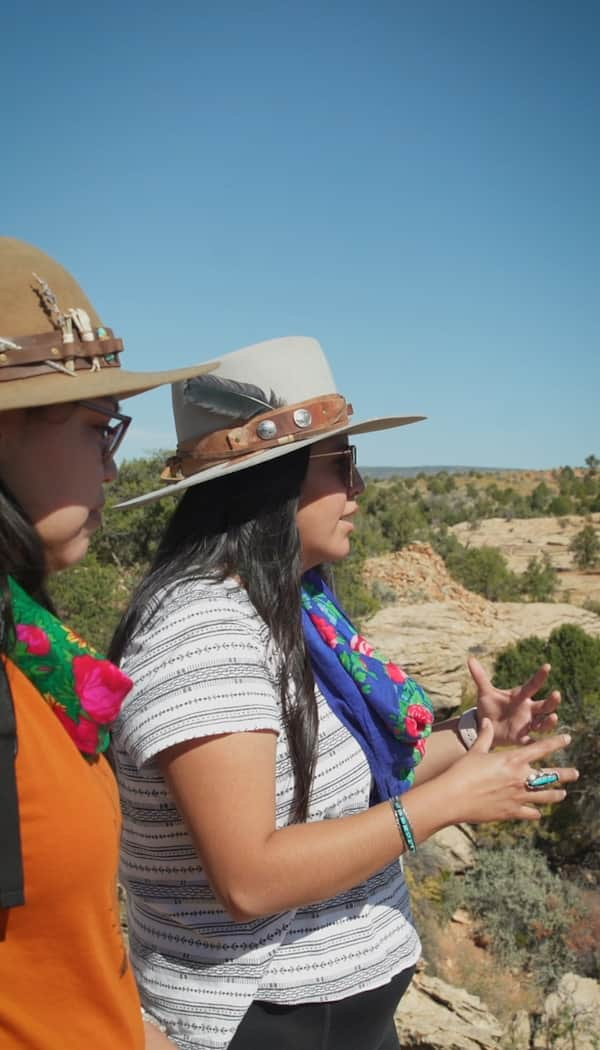Following the Markings of Native American History
A sample itinerary to help you find an incredible window into Utah's Indigenous heritage.
Utah is known for its natural beauty. But take a closer look and you’ll discover that the dusty red sandstone covering much of the state tells a story as well. People lived in this part of the country for thousands of years before European settlement, and you can see signs of these ancient Indigenous cultures in the petroglyphs and pictographs that they left behind.
A road trip is a great way to explore these markings of ancient native history — in addition to seeing some of the most amazing scenery in the country. You can spend your time hiking among Utah’s most beautiful landscapes while learning about the people who came before us.
To get you started, we’ve put together a sample itinerary, starting in Vernal near the Colorado border. But you can easily make the trip in reverse order or pick and choose elements that work best for you. No matter which stops you make, you’ll find an incredible window into the past.
But before you get on the road, it’s best to find out a little bit more about Utah's early history...
Pre-European settlement in Utah is classified into three main categories, starting with the Archaic Indian Period from 7500 B.C. to approximately 300 A.D. That’s followed by the Fremont/Anasazi Indian Period, which overlaps slightly from 100 A.D.-1300 A.D. The last grouping is the Ute Indian Period, from 1300 A.D.-1880 A.D. A range of pictographs and petroglyphs (often referred to as “rock art,” though the intention of the work is unknown) from each can be found all over the state.
Descendants from these ancient people now make up the major tribes of Utah: the Ute, Dine' (Navajo), Paiute, Goshute and Shoshone. The predecessors of these tribes created two categories of images in the rock. Petroglyphs are made with some type of tool that removed bits of the rock, while pictographs are more like paintings, made with pigments added to the surface of the stone. While some of the art may have originally been a combination of the two styles, the ravages of time have left behind primarily petroglyphs.
The figures found in these panels range from geographic designs (that many researchers believe represent abstract thoughts such as “the after-life”) and human or animal figures — sometimes engaged in activities. What do they all mean? That’s tough to say, as no translation is available. Experts speculate that, as you’d probably expect, the pictures were a way to tell their stories. Perhaps they are instructions for hunting or growing crops. They could be historical remembrances or mythology. Part of the fun is in speculating about what the message might be.

Salt Lake City to Vernal
173 Miles
The adventure starts in the small town of Vernal, about three hours east of Salt Lake City. Here you’ll find some of the best examples of Fremont Indian panels located on private property just outside of town. The McConkie Ranch petroglyphs decorate the cliffs along a short but sometimes steep trail of just under a mile. The Fremont are distinguished from some of the other nearby tribes because they were a bit less nomadic, creating semi-permanent settlements where they were known to grow crops versus solely relying on a hunting/gathering tradition.
Also known as the Dry Fork Canyon petroglyphs, many of the markings here are very large and easy to see. Some of the more famous of the petroglyphs feature a bit of blood and gore as well as peaceful pastoral scenes. The variety, quality and size of these petroglyphs make them one of the most important records of an ancient culture that has survived.
There is a requested $5 donation to hike. Particuarly in the warm summer months, hikers should bring plenty of water.
Where to stay: Vernal
An ideal basecamp for visiting Dinosaur National Monument, Red Fleet State Park, Steinaker State Park or the Utah Field House of Natural History State Park Museum, Vernal is also a gateway to outdoor adventure, including hiking, mountain biking, rafting and more.
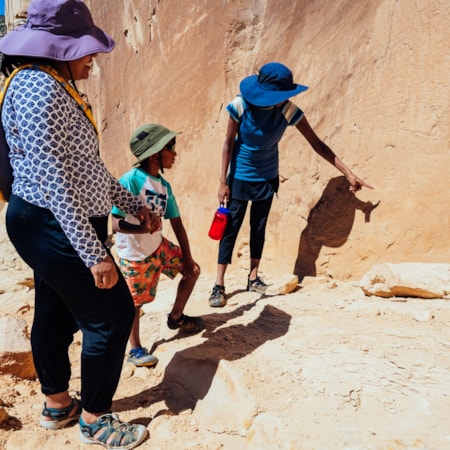
Dinosaur National Monument
50 Miles
A quick 20 minutes further east of Vernal, you’ll find the Dinosaur National Monument. In addition to being one of the best places in the country to see well-preserved dinosaur fossils, this area is a treasure trove of ancient Indigenous art (Read: Reef Walking, Petroglyphs and Bones). You’ll find multiple locations around the monument for viewing both petroglyphs and pictographs. Some of the can’t-miss spots to visit on your trip include:
McKee Spring: If you’ve only got time for one site at Dinosaur National Monument, McKee Spring is the place to go. The petroglyph panels are of high quality and easily accessible.
Tilted Rocks: The art here is plentiful and diverse. The best drawings require a bit of effort to see up a steep hill about 200 yards up the trail. The memorable forms here are the lizard drawings.
Echo Park: Petroglyphs are scattered all over the Echo Park area. Many are located on a ledge above the campground, some are at Pool Creek, and others are found across the Green River from the raft-launch site.
Jones Hole Trail: The rocks at Jones Hole are some of the most impressive pictographs at Dinosaur National Monument. Keep an eye out for what could be a shaman (holy man) and bighorn sheep.
Mantle Cave: This area is accessed from paddling the Yampa River. Visitors can follow a well-defined path uphill through the brush for about half a mile to the cave’s entrance.
Where to stay: Vernal
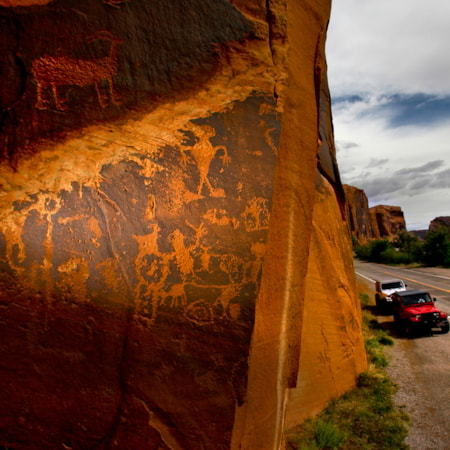
Vernal to Moab
223 Miles
- Sego Canyon Rock Art Interpretive Site
- Potash Lower Colorado River Scenic Byway
- Dinosaur National Monument
About a three-hour drive south of Dinosaur National Monument, Moab is one of the most popular outdoor towns in the state. It’s known for its camping, hiking, mountain biking, stargazing, two national parks — plus a wide number of sites worth visiting with native petroglyphs and pictographs. If time is an issue, this might be your “one-stop that has it all” destination. Some highlights include:
Sego Canyon: Sego provides displays of panels from all three time periods, and has both petroglyphs and surprisingly colorful pictographs. This makes it easy to compare the different styles.
Golf Course Rock Art Site: Perhaps the most accessible of the sites listed is exactly what it sounds like. A petroglyph panel in a neighborhood near the golf course in Moab. The drawings, which can be seen from the parking area but should be seen close up, are a mix of Fremont and Anasazi likely dating back to between 1 to 1300 AD.
Where to stay: Moab
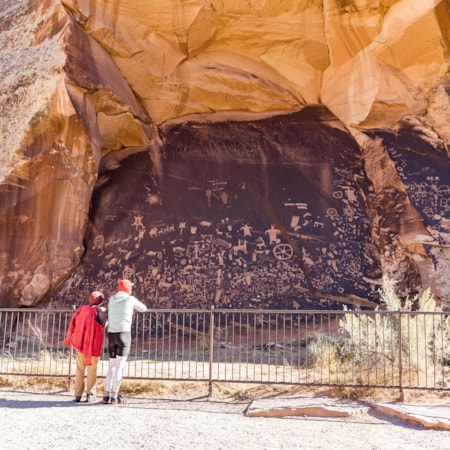
Canyonlands National Park
75 Miles
Just a half-hour west of Moab, Canyonlands National Park is a treasure trove of pictographs and petroglyphs with a variety of sites throughout the park. The two most significant options are:
Newspaper Rock: This is the easy option. It’s likely the best-known (and certainly the most photographed) petroglyph example in the country. Newspaper Rock, part of the Indian Creek Corridor unit of Bears Ears National Monument, features examples of drawings from a variety of cultures, including the Archaic Indians, Fremont, Anasazi, Navajo and other Ancestral Puebloan peoples.
Horseshoe Canyon and the Great Gallery: This is the harder option. The middle of nowhere is a pretty accurate description of this section of the park. However, the 7-mile strenuous hike is certainly worth the effort for the best-preserved examples of Barrier Canyon-style rock art in the country. The most famous of the panels is the Great Gallery, but three other sites can be seen along the hike. (Read: Ancient Pictographs, Petroglyphs and Timeless Mysteries)
Where to stay: Moab
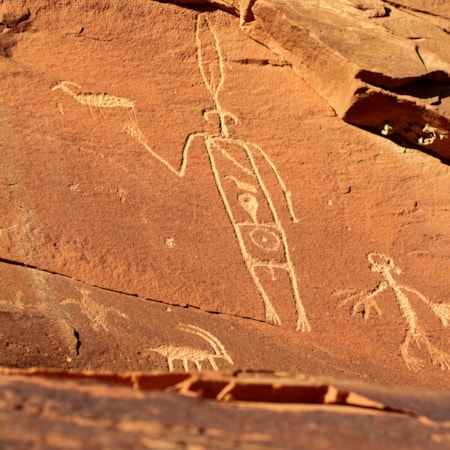
Bluff
80 Miles
About an hour and 45 minutes south of Canyonlands, in the southeast corner of Utah, Bluff is considered the gateway to the new Bears Ears National Monument, and many fine examples of Ancestral Puebloan art are located in the vicinity.
In Town: Five prehistoric panels are located near town and you can find them on the Bluff walking tour map.
Sand Island Petroglyph Panel: This is another fantastic, easy-to-reach site, and one of the most prolific and well-preserved examples of Anasazi petroglyphs.
Big Kachina Panel: This one requires a bit more effort to see as it only be accessed by boat on the San Juan River, by Jeep or by hiking in — it’s next to River House site, which is also worth a visit.
Visitors come to southeastern Utah year-round, but most come during spring and autumn to best enjoy the high-desert environment. Temperatures may reach mid-90s F in July and August. Summer visitors can beat the heat by planning ahead, carrying sunscreen and extra water, and playing in the morning and evening. Clear, warm, sunny days and cool nights make September one of the most delightful months to visit.
Winter can be cold, although there will be some nice days. Average highs in the winter are in the 40s, so you'll want to pack layers and water when you venture out to enjoy serene, sometimes snow-dusted, panoramas.
Where to stay: Bluff
Tucked between sandstone cliffs and the San Juan River, rich in human and natural history, Bluff is a central point along the Trail of the Ancients National Scenic Byway. It serves as a gateway to quintessential southeastern Utah destinations such as Monument Valley, Bears Ears National Monument, Valley of the Gods and Hovenweep National Monument.
